You are using an out of date browser. It may not display this or other websites correctly.
You should upgrade or use an alternative browser.
You should upgrade or use an alternative browser.
APL's Pressure Contact Battery box
- Thread starter APL
- Start date
spinningmagnets
100 TW
That is what was done often in the past, but for high-amp applications, the nickel converts a lot of battery watts into waste-heat. Now that the copper-nickel sandwich has been tested and verified, there is less waste-heat and less voltage drop over the buses. Copper also costs less and is easily cut with scissors when using 0.10-0.15mm sheet.
Of course, if someone wants to continue to layer additional nickel on the buses, everyone is free to do so.
Of course, if someone wants to continue to layer additional nickel on the buses, everyone is free to do so.
APL
100 kW
- Joined
- Aug 6, 2018
- Messages
- 1,113
Saw this chart the other day, thought it was interesting. If you look at a square wire from the end cross section, then
the other metals on the chart need to be that much bigger to have the same current capacity as silver.
Doesn't show nickel, but the specific resistance number of Copper is 16.8, Alum. 28, Brass 66, Nickel 69.9, and Bronze 140.
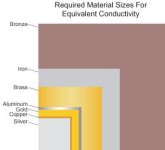
Still working on the battery, just so many other things taking up the time. More progress coming soon.
the other metals on the chart need to be that much bigger to have the same current capacity as silver.
Doesn't show nickel, but the specific resistance number of Copper is 16.8, Alum. 28, Brass 66, Nickel 69.9, and Bronze 140.

Still working on the battery, just so many other things taking up the time. More progress coming soon.
ZeroEm
1 MW
I stole your image. 8)
Looks like Aluminum would be a good conductor for a house battery maybe come copper sheet. My batteries are on the way. Going to give pressure contact a try. Maybe punched copper sheet, thought about Aluminum, it does not react well with copper. That the reason for Nickle?
Looks like Aluminum would be a good conductor for a house battery maybe come copper sheet. My batteries are on the way. Going to give pressure contact a try. Maybe punched copper sheet, thought about Aluminum, it does not react well with copper. That the reason for Nickle?
APL
100 kW
- Joined
- Aug 6, 2018
- Messages
- 1,113
My thoughts exactly, aluminum is a better conductor than nickel. It oxidizes though, and is brittle, so maybe that
is enough to rule it out? Don't know what it welds like, so maybe that has something to do with it too.
As far as pressure contact though, copper has them all beat. (except for silver)( We just have to find a Spanish Galion
somewhere..)
New batteries eh? Lucky you!!! What did you settle on?
What did you settle on?
is enough to rule it out? Don't know what it welds like, so maybe that has something to do with it too.
As far as pressure contact though, copper has them all beat. (except for silver)( We just have to find a Spanish Galion
somewhere..)
New batteries eh? Lucky you!!!
ZeroEm
1 MW
Have a box 320+ used 26650 LiFePO4 coming. Think maybe to bulky. Going to make 12V pressure contact battery. Wanting to have 12v groups (4p5s) to reconfigure into a bike battery if wanted later. Need some backup power first. Will have time to think until the Bike starts coming together. No frame yet. About everything else even wheels.
APL
100 kW
- Joined
- Aug 6, 2018
- Messages
- 1,113
320 26650 cells are going to make anything rip, you like to dance with danger eh? Is it the Dark Side? We understand. 
EDIT; Unless your going for range of course, which I suspect,.. (just my own power hungry assumption getting in the way.)
I like the 12v idea,.. easy to make, and easy to change volts. Sounds like you've got the plan, and this is going to be
an awesome bike!
EDIT; Unless your going for range of course, which I suspect,.. (just my own power hungry assumption getting in the way.)
I like the 12v idea,.. easy to make, and easy to change volts. Sounds like you've got the plan, and this is going to be
an awesome bike!
APL
100 kW
- Joined
- Aug 6, 2018
- Messages
- 1,113
Finally got the phenolic cut for the box sides, used a small particle blade outside because of the dust. I cut a smaller
strip to space the back side out 3/16" for the wires to run in on each side. I'll run two power leads from the bottom
buss to even things out with the top buss, current wise.
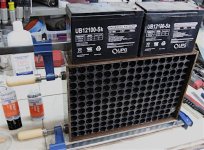
The Permatex 30 minute epoxy I've been using has be working well and I'm liking this stuff so far.
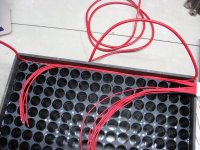
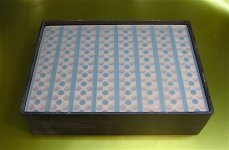
I still have to figure out a decent way to mount the strips to the sheet yet, I was thinking of putting RTV in each dimple,
but I'd still like to use a few rivets too, or something like it.
Not too sure about metal bolts either, I can insulate them all right, but still get a queasy feeling about it. I thought
about using threaded nylon rod, but I'm not sure about the strength. (5/16")
strip to space the back side out 3/16" for the wires to run in on each side. I'll run two power leads from the bottom
buss to even things out with the top buss, current wise.

The Permatex 30 minute epoxy I've been using has be working well and I'm liking this stuff so far.


I still have to figure out a decent way to mount the strips to the sheet yet, I was thinking of putting RTV in each dimple,
but I'd still like to use a few rivets too, or something like it.
Not too sure about metal bolts either, I can insulate them all right, but still get a queasy feeling about it. I thought
about using threaded nylon rod, but I'm not sure about the strength. (5/16")
APL
100 kW
- Joined
- Aug 6, 2018
- Messages
- 1,113
Yea, that's the plan, poly or nylon sleeves, or maybe just where the copper is. It's just that small area that needs it.
The copper strips will be offset on each side, so the bolts will be going through the mid-holes on the strips in places,
as well as in between them. Still queasy since the bolt sleeves might not be very thick. 1/4" bolts, 5/16" hole,..
(might be able to make it a 3/8" hole.)
Not that anything is going to be moving around, but nonconductive nylon threaded rod would eliminate the possibility
all together.
They tend to get brittle with age though, and the look of nylon bolts and nuts can be nasty, although the nuts can be
steel or alum.
The copper strips will be offset on each side, so the bolts will be going through the mid-holes on the strips in places,
as well as in between them. Still queasy since the bolt sleeves might not be very thick. 1/4" bolts, 5/16" hole,..
(might be able to make it a 3/8" hole.)
Not that anything is going to be moving around, but nonconductive nylon threaded rod would eliminate the possibility
all together.
They tend to get brittle with age though, and the look of nylon bolts and nuts can be nasty, although the nuts can be
steel or alum.
goatman
10 MW
APL
100 kW
- Joined
- Aug 6, 2018
- Messages
- 1,113
Thanks goatman, That's good to know, I'll look around at 4mm + 5mm bolts/screws..
(when does a bolt become a screw?) :?
If I make the holes in the spacers big enough I should be able to slide a few mm of insulation over the screws.
At the moment I'm thinking Rivnut or T-nut on one panel, with a large stainless washer under it, and a conical alum.
washer on the other side, to help spread out the load a bit more.
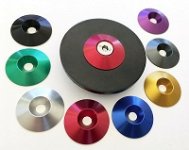
The screws are acting more like spokes at this point, but the tension probably isn't very much. We shall see.
(when does a bolt become a screw?) :?
If I make the holes in the spacers big enough I should be able to slide a few mm of insulation over the screws.
At the moment I'm thinking Rivnut or T-nut on one panel, with a large stainless washer under it, and a conical alum.
washer on the other side, to help spread out the load a bit more.

The screws are acting more like spokes at this point, but the tension probably isn't very much. We shall see.
goatman
10 MW
CNC kitchen on youtube does quite a bit of strength testing of 3d, this ones on threads,heli coils and embedded nuts
https://www.youtube.com/watch?v=2wRc1KbEAU8
https://www.youtube.com/watch?v=2wRc1KbEAU8
TorontoBuilder
100 W
DogDipstick said:If you want to try that Poron foam rubber stuff ( Mr.SpinningMagnets suggestions above... ) let me know. I got a ton. Its used against cells in EV modules. ... pay for a flat rate SASE and Ill stuff it up for ya.
I like strapping things with tension. Personally, its easy for me and my strapping tools. Retains tansion well.
I make punching dies alot. I got big plans for mass punching of tinned copper strip plate for bussing.
Hey dog, is that offer open to anyone? APL inspired me to take this approach rather than the NESE boxes.
I intend on making a few large battery packs, including one for under the floor of a sidecar using compression and stamped copper bus bars. That way I can make use of cheap low Ah cells I can source here in Canada.
TorontoBuilder
100 W
goatman said:i got some countersunk m4 x 70mm long off amazon.ca, with a 1.95 r hole they hold solid
https://www.amazon.ca/Machine-Plated-Phillips-Threaded-Threads/dp/B00918H4Q0/ref=sr_1_1?dchild=1&keywords=m4+x+70mm+long+screw&qid=1635634391&sr=8-1
IMG_20211030_154725.jpg
If you need longer than 70 mm, which I think I will for my design, they make 1 meter x 4 mm threaded rod to cut custom lengths from.
I would add a strong rigid outermost sheet of insulating material
let the threaded rod come all the way through
with the nylon insulating rod staying below the holder plane
then wide fender washers spreading the squeeze contact pressure applied by the outermost nuts
let the threaded rod come all the way through
with the nylon insulating rod staying below the holder plane
then wide fender washers spreading the squeeze contact pressure applied by the outermost nuts
DogDipstick
100 kW
TorontoBuilder said:Hey dog, is that offer open to anyone? APL inspired me to take this approach rather than the NEME boxes.
Sure if you want to pay for an envelope. I can stuff a typical envelope with like 15-20. They are 6 x 10 x 0.20 inch Foam sheets from OEM Chevy volt modules ( so you know they are good and long lasting quality).
I got hundreds here. Just PM me, I'll set up an envelope, quote it, and pm you back. I ship four or five things per week. No biggie. Just carry the hobby along and teach a kid about batteries, thats all I ask.
APL
100 kW
- Joined
- Aug 6, 2018
- Messages
- 1,113
Thanks john61ct, that's the idea alright. I'm using 3/16" outer compression sheets of Phenolic sheet, which is pretty stiff,
but it's a big box so I have my fingers crossed on that.
This box is becoming a big hefty hunk of plastic, copper, and phenolic sheet, so I can't really recommend it as any kind
of design advancement,.. it's Tank pure and simple, but by jangles it's going to be strong and safe. (hope)

Compression sheet thickness shouldn't matter that much if the thru bolts are spaced right, which is the next question,...
how many? How much space can I get away with between bolts? At the moment I'm thinking 12 screws, with maybe a few
more along the end bus bars to insure full contact there, with slightly thicker Poron strips at that point.
The Poron thickness is the next unknown,.. I'd like to use a 1/4" thick sheet. But I think it crushes 25 percent at full
usable compression, so maybe I should use 3/8" thick sheet. Poron is cheaper than silicone, so I'll try that first.
When it comes down to testing the darn thing, I racked my brain for a while trying to figure out how to know if some
cells aren't making contact.
At the moment I figure; first, give it the full throttle test to see if it delivers the 1.5Kw that the other battery gave.
(13S/10P) If less.. something is wrong. (This is a 16S/11P pack.)
Then drain the cells down a bit, take the pack apart, and check for full charge cells. They will be the no-contact's.
but it's a big box so I have my fingers crossed on that.
This box is becoming a big hefty hunk of plastic, copper, and phenolic sheet, so I can't really recommend it as any kind
of design advancement,.. it's Tank pure and simple, but by jangles it's going to be strong and safe. (hope)

Compression sheet thickness shouldn't matter that much if the thru bolts are spaced right, which is the next question,...
how many? How much space can I get away with between bolts? At the moment I'm thinking 12 screws, with maybe a few
more along the end bus bars to insure full contact there, with slightly thicker Poron strips at that point.
The Poron thickness is the next unknown,.. I'd like to use a 1/4" thick sheet. But I think it crushes 25 percent at full
usable compression, so maybe I should use 3/8" thick sheet. Poron is cheaper than silicone, so I'll try that first.
When it comes down to testing the darn thing, I racked my brain for a while trying to figure out how to know if some
cells aren't making contact.
At the moment I figure; first, give it the full throttle test to see if it delivers the 1.5Kw that the other battery gave.
(13S/10P) If less.. something is wrong. (This is a 16S/11P pack.)
Then drain the cells down a bit, take the pack apart, and check for full charge cells. They will be the no-contact's.
ZeroEm
1 MW
Have been stalking you. Have been thinking about the same thing. I like that idea. know what voltage they are then charge up or discharge down. Just wondering is low amp may not show up as much as higher amps.
Going to build a home compression batter first. After learning will move on to my trike battery. My current battery on my trike has went out of balance. The BMS shut down at 74.5v on a 20s so it's bad going to rip it open soon so cell groups can be tested. Now I wished it was a compression battery.
Going to build a home compression batter first. After learning will move on to my trike battery. My current battery on my trike has went out of balance. The BMS shut down at 74.5v on a 20s so it's bad going to rip it open soon so cell groups can be tested. Now I wished it was a compression battery.
Then drain the cells down a bit, take the pack apart, and check for full charge cells. They will be the no-contact's.
DogDipstick
100 kW
Pic of my most recent enclosure. Coming together. In the background you see the two 10s stacks of Chevy cells that are gonna be housed in that "compression housing" (... aka my idea of a 'really strong box') and the sheets of Poron on top. This pack gets its balance leads crimpped, main 4 gage in and Im done.
Lol you are not alone in the chunk of plastic, copper, rubber, and cells, construction. I'll post one pic when Im done.
Lol you are not alone in the chunk of plastic, copper, rubber, and cells, construction. I'll post one pic when Im done.
Attachments
goatman
10 MW
while playing with magnets i found p-groups will go out of balance
if im pulling 40amps from 4p of 5mm magnets, groups go out of balance(10amps/cell)
20amps from from 4p- 5mm magnets, pack stays balanced(5amps/cell)
7.5mm and 10mm magnets, 4p packs stay balanced at 40 amps
if you had something like a ebc-a20 battery tester you could see how the connection performs on the discharge graph with different amps and compression
magnets do pounds of pull, when trying to figure out how much force would be needed i did a quick calculation in this post
https://endless-sphere.com/forums/viewtopic.php?f=14&t=106190&hilit=magnets&start=125#p1623006
if im pulling 40amps from 4p of 5mm magnets, groups go out of balance(10amps/cell)
20amps from from 4p- 5mm magnets, pack stays balanced(5amps/cell)
7.5mm and 10mm magnets, 4p packs stay balanced at 40 amps
if you had something like a ebc-a20 battery tester you could see how the connection performs on the discharge graph with different amps and compression
magnets do pounds of pull, when trying to figure out how much force would be needed i did a quick calculation in this post
https://endless-sphere.com/forums/viewtopic.php?f=14&t=106190&hilit=magnets&start=125#p1623006
I would put the compression bolts every 3-4 cells
maybe allows the outer board to not be so thick?
The poron "springs" could be cut discs, it is insulating maybe blocking heat dissipation?
but yes maybe cheaper and certainly easier to just use a full sheet
maybe allows the outer board to not be so thick?
The poron "springs" could be cut discs, it is insulating maybe blocking heat dissipation?
but yes maybe cheaper and certainly easier to just use a full sheet
drdrs
1 W
- Joined
- Jun 10, 2018
- Messages
- 50
The first Vruzend pack I built had some poor contacts before I added compression plates.
To diagnose the bad p-groups, I used the smart BMS report of each p-group voltage during charging. P-groups with a bad contact would charge more quickly and the slope of the voltage was higher.
This was detectable on a 5p battery, but it may be harder to see on a 10P or 11P pack.
Once the pack is out of balance, you can also watch the voltages jump around during increased compression as the row equalizes.
Here is an app I built for the Energus BMS. I'm using the ENNOID BMS now, but haven't posted that app.
https://github.com/dsoto/Tiny-BMS-Monitor
To diagnose the bad p-groups, I used the smart BMS report of each p-group voltage during charging. P-groups with a bad contact would charge more quickly and the slope of the voltage was higher.
This was detectable on a 5p battery, but it may be harder to see on a 10P or 11P pack.
Once the pack is out of balance, you can also watch the voltages jump around during increased compression as the row equalizes.
Here is an app I built for the Energus BMS. I'm using the ENNOID BMS now, but haven't posted that app.
https://github.com/dsoto/Tiny-BMS-Monitor
Similar threads
- Replies
- 7
- Views
- 943
- Replies
- 106
- Views
- 8,114
- Replies
- 16
- Views
- 1,454
- Replies
- 26
- Views
- 10,309



